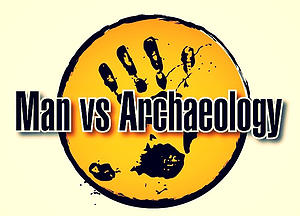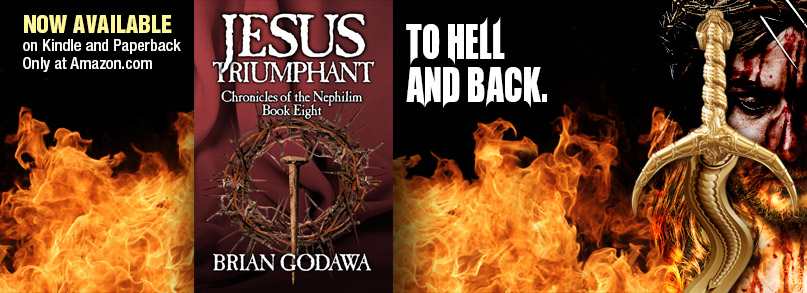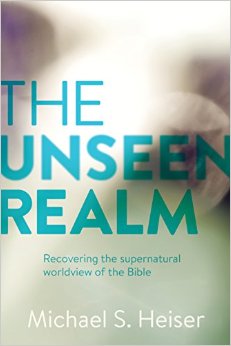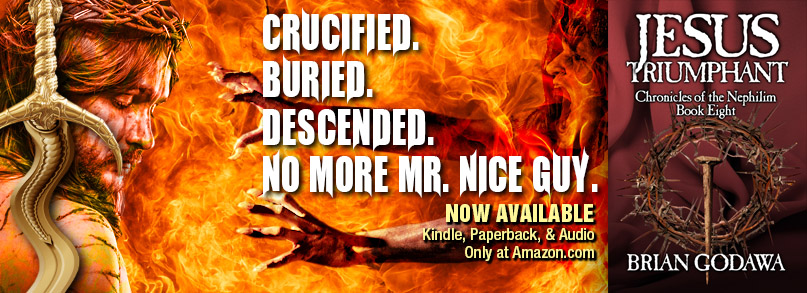Listen to Epic Voyages Radio Interview of Godawa here.We talk about the rise and fall of the Nephilim in the Biblical Cosmic War of the Seed. Watchers, giants, and other bizarre phenomena of the Bible as it appears in the novel series, Chronicles of the Nephilim.
The host of the show, Dr. Aaron Judkins aka “Maverick” is an author, explorer, & archaeologist from Texas. He has a passion for searching for the truth about the mysteries of the past- exposing forbidden archaeology & forbidden history. He appears in the new documentary “Finding Noah,” about the current search for Noah’s Ark.
nephilim
Christ’s Descent into Hell (Part 2)
In a previous post, we started looking at one of the most difficult and strange passages in the New Testament, 1 Peter 3:18-22. Many Christians avoid passages like this because they are difficult and hint at content that doesn’t fit well with their own theological views.
Let’s take another look at it with an attempt to clarify its meaning.
1 Peter 3:18–22
For Christ also suffered once for sins, the righteous for the unrighteous, that he might bring us to God, being put to death in the flesh but made alive in the spirit, in which he went and proclaimed to the spirits in prison, because they formerly did not obey, when God’s patience waited in the days of Noah, while the ark was being prepared, in which a few, that is, eight persons, were brought safely through water. Baptism, which corresponds to this, now saves you, not as a removal of dirt from the body but as an appeal to God for a good conscience, through the resurrection of Jesus Christ, who has gone into heaven and is at the right hand of God, with angels, authorities, and powers having been subjected to him.
In the previous post, I explained the two main views that Christ either “went” somewhere in his spirit body during his death on the cross or he “went” after he resurrected BEFORE he ascended into heaven. Then I proved that the “spirits in prison” were not humans but the angelic powers who had fallen during the days of Noah, and were imprisoned much like the book of 1Enoch says. (And Peter is borrowing from 1Enoch)
The last two questions we now want to address are:
Where did he go to proclaim to the spirits? (v. 19)
What did he proclaim? (v. 19)
Where is the “Prison”?
One interpretation of the prison is that it is a metaphor for human beings on earth who are “imprisoned” in their sin. But the context of the passage mitigates against this view.
When the New Testament refers to preaching the Gospel to people on earth, the Greek term for “soul,” is used (psyche). But this is not a term about a ghost in a machine, but rather an expression of the life of an individual human, their inner being, their “person,” or their “self.” Thus, Peter writes in 3:20 that “eight persons (psyche) were brought safely through the waters” in the ark during the Flood.
When Peter preaches the Gospel in Acts 2, it says that “those who received his word were baptized, and there were added that day about three thousand souls [psyche]… and awe came upon every soul [psyche]” (Acts 2:42-43). “Soul” could be used synonymously with “individuals” or “persons.”
But in 1 Peter 3, the distinct Greek term for “spirit” (pneuma), not “soul” (psyche), is used in contrast to the physical flesh. And these “spirits” are those who were disobedient in the days of Noah (v. 20), so they could not be people on earth at the time of Christ. Christ was proclaiming to spirits.
During the time of Christ, those who were around in the days of Noah could only be in one place according to the Old Testament: The underworld of Hades or Sheol.
What was Hades?
Hades was well known in the Greco-Roman world as the holding cell of the spirits of the dead until the judgment. Sheol was the Hebrew equivalent for Hades so the two could be used interchangeably.[1] Prisons in that time period were exactly that, holding cells for punishment. So when Peter refers to a prison for spirits, this view concludes that he is referring to Hades, just as he did in 2 Peter 2:4 when he said that the disobedient angels were cast into Tartarus, the lowest prison region in Hades.
There are orthodox traditions of Christian scholars who have supported this passage as referring to Christ’s proclamation as occurring at his physical ascension into heaven and others as referring to Christ’s spiritual descent into Hades. I take the position in Jesus Triumphant that Christ spiritually descended into Hades. So did early church fathers like Tertullian, Augustine, Jerome, Clement of Alexandria, Irenaeus, Cyril, and Origen, as well as Medieval scholastics like Robert Bellarmine, John Calvin, Thomas Aquinas, and modern scholars like Charles B. Cranfield, and Bo Reicke.[2] But I also incorporate the post-resurrection interpretation as well, with its fascinating possibilities.
 1 Enoch, which seems to be the source of the Biblical text, does in fact depict Enoch as visiting the place of the condemned Watchers who were “formerly in heaven” (1 Enoch 16:2), and that place is described as a “deep pit,” in the bottom of a mountain, just like Tartarus of Hades (Sheol), “an empty place with neither heaven above nor an earth below” (1 Enoch 21:1-2).[5]
1 Enoch, which seems to be the source of the Biblical text, does in fact depict Enoch as visiting the place of the condemned Watchers who were “formerly in heaven” (1 Enoch 16:2), and that place is described as a “deep pit,” in the bottom of a mountain, just like Tartarus of Hades (Sheol), “an empty place with neither heaven above nor an earth below” (1 Enoch 21:1-2).[5]
The descent of Christ in 1 Pet. 3:19 is poetically structured to counterbalance the ascent of Christ into heaven in verse 22. In the same way that Christ went down into Sheol, he later ascended up into heaven. But more importantly, if Christ makes a proclamation to the spirits in prison, those dead and bound prisoners are certainly not in heaven. They are most likely in Sheol.
Another passage, Ephesians 4:8 quotes Psalms 68:18 about Christ “ascending on high and leading a host of captives.” Paul then adds a parenthetical,
Ephesians 4:9-10
“In saying, ‘He ascended,’ what does it mean but that he had also descended into the lower regions, the earth? He who descended is the one who also ascended far above all the heavens, that he might fill all things.”
Christ “descending into the lower regions, the earth” can legitimately be interpreted as referring to Christ’s incarnation or even his descent in the Spirit on Pentecost.[6] But other scholarship argues that the phrase is better translated as “descending into the lowest parts of the earth,” in other words into Sheol.[7]
This underworld (Sheol) interpretation would seem to coincide with the memes presented in 1 Peter 3. The contrast of the heights of heaven with the depths of Sheol, and the tying of Christ’s death, descent into Sheol, resurrection, and ascension into the totality of his victory over the angelic principalities and powers.[8]
Psalm 68 says that after leading the host of captives, God “received gifts from men,” a reference to the notion of ancient victors receiving tribute from their conquered foes. Paul changes that “receiving of gifts” into “giving of gifts” as a expansion of that victory over foes into a sharing of victory with his army, the people of God. Perhaps this is the meaning of the Old Testament saints resurrected at the time of Christ’s resurrection (Matt. 27:52-53). They too were sharing in the long awaited victory train of Messiah to free them from Hades and ascend into heaven.
The context of conquest over the angelic powers is also apparent in Eph. 1:20-21, “when he raised [Jesus] from the dead and seated him at his right hand in the heavenly places, far above all rule and authority and power and dominion, and above every name that is named.”
Christ’s death on the Cross becomes the apparent defeat by God’s enemies, led by angelic principalities and powers. But it turns around and becomes a disarming of those spiritual powers and the beginning of his triumph over them (Col. 2:15). In this view, Christ goes down into Sheol (in his spirit or later, in his resurrected body) to make a proclamation to the original minions of evil, now held captive. After he raises from the dead, he ascends into heaven to be coronated as king over all authority and powers of heaven and earth (Eph. 1:20-21). And that victory over spiritual powers brings us to the next element of 1 Peter 3:18-22.
What was the Proclamation?
Kuyperian Commentary Interviews Godawa on Jesus Triumphant and the Nephilim
Uri is a great interviewer. We talk about the storyline of the Cosmic War of the Seed in the Bible, which could also be referred to as the “Christus Victor” motif. We speak of the Tower of Babel, and the Alottment of the nations under the Watcher Sons of God. And how Jesus disinherits the nations from the gods and has victory over the heavenly principalities and powers. We talked about the Divine Council, and the Nephilim throughout the entire Bible, and how they even show up in the Gospels. I’m not kidding. It’s all orthodox and affirms a high view of the Bible as God’s Word.
Buy Jesus Triumphant on Kindle and paperback at Amazon here.
Disclose Truth TV Interviews Godawa on Nephilim, Watchers, & Bizarre Bible Passages
This interview was lively. I talk with James Swagger and Susan Kornacki about the Biblical and ancient historical and mythical research of the Nephilim.
The Nephilim in the Bible is controversial. But Genesis 6 is not the only place they show up. This interview explores everywhere giants appear in the Bible, and there are many of them. Nephilim and demons. Satan’s place as “god of this world.” The Transfiguration of Christ as a declaration of war on the Watchers.
Capricorn Radio website (The website of James Swagger)
The Unseen Realm: This Book is a Game-Changer for Evangelical Christianity
Psalm 82
God has taken his place in the divine council; in the midst of the gods he holds judgment.
That was the Bible chapter that started the journey for author and scholar, Michael Heiser. He describes in his book that he had come from a traditional Evangelical background, so the notion of there being other “gods” beside Yahweh was anathema. Monotheism means there is only one God, right?
But as he sought to understand what it all meant, it opened up a whole new world of theological messaging that reveals the supernatural worldview of the Bible.
And that is what this book did for me. I dedicated my bestselling Biblical Fantasy series first novel, Noah Primeval to Michael Heiser because this theological messaging helped open my eyes to my own modern Christian ignorance of the ancient Near Eastern background of the Bible. Like Elisha’s servant opening his eyes to see the myriad of heavenly host surrounding the valley, so I now saw God’s heavenly host as part of a storyline of redemption that traditional Evangelicalism has missed or misunderstood because of its obsession with modern categories and hermeneutics when interpreting the Bible. (Full disclosure: I now know Michael Heiser personally after reading an early draft of the book)
Heiser lays out a Biblically strong argument that can be read and understood by laity. What is so cool is that it is not just an argument, it is a story. He is clear, concise, and very readable without falling into that trap of abstraction and dry prose that many scholars fall into.
But make no mistake, Heiser is a scholar. His emphasis is in the fields of Biblical Studies and the Ancient Near East. He is published widely in scholarly journals and even has online courses in Hebrew, Greek, Ugaritic (the language of ancient Canaan) Akkadian, Egyptian and Aramaic. This scholarly dude has academic bona fides and he cannot be dismissed. Which is why I think this book will be a game-changer in Evangelical theology. Read it, and you’ll be on the crest of an exciting wave of fresh understanding of the Scriptures.
Heiser avoids both extremes of conservative hyper-literalism and liberal critical demythologizing. He seeks to interpret the text within its ancient Near Eastern context rather than the modern one, which is where both conservative and liberal scholars fail.
Here are just a few of the amazing discoveries you will encounter when reading the book…
The Divine Council
Psalm 89:6–7
For who in the skies can be compared to the Lord? Who among the gods is like the Lord, a God greatly to be feared in the council of the holy ones, and awesome above all who are around him?
God is surrounded by a myriad of heavenly host who are called by many names, like, “gods, “Sons of God,” “Holy Ones,” and “divine council.” They are not merely “angels” floating around his throne, they are divine beings. Yes, divinity in the Bible is not the exclusive prerogative of Yahweh, and it isn’t the same thing as Mormons think either. And these heavenly host have more to do than merely singing “glory” and shining up the place with their bronze-like brightness. They counsel with God (Job 1, 2) and perform tasks appointed by God (1Kings 22), they mediate the Law of God to man (Galatians 3:19 ), perform as witnesses to God’s covenants and curses (Deut 33:1-4; Zech 2-3), and engage in heavenly wars (Daniel 10). There is so much more to these divine beings than meets the casual Bible reader’s eye.
Sons of God and the Nephilim
Genesis 6:4
The Nephilim were on the earth in those days, and also afterward, when the sons of God came in to the daughters of man and they bore children to them. These were the mighty men who were of old, the men of renown.
Okay, this is where a lot of popular Bible teaching gets goofy. But not Heiser. He deftly proves that the Sons of God were not human, but supernatural divine beings from God’s heavenly host, who fell to earth in rebellion and produced diabolical progeny of giants called Nephilim. Yes, giants, NOT merely human “fallen ones.”
This is not some Ancient Aliens mythology, nor is it the sensationalist version that many Christian Nephilim Nuts are teaching. There is a reason for it all, and it has to do with the war between the Seed of the Serpent and the messianic Seed of Eve (Gen. 3:15). And it comes into play many other times in the Old Testament. Many western readers miss it because of our modernist cultural prejudice.
The Divine Allotment
Deuteronomy 32:8–9
When the Most High gave to the nations their inheritance, when he divided mankind, he fixed the borders of the peoples according to the number of the sons of God. But the Lord’s portion is his people, Jacob his allotted heritage.
At the Tower of Babel, God “gave over” the godless to their idols (Romans 1). he placed them under the authority of fallen Sons of God. They are allotted as an inheritance. Each pagan nation is ruled over by these territorial “principalities and powers” who own the deeds to their lands (Daniel 10; Col 2:15; Eph. 6:12). It’s like these fallen gods of the nations are linked to their earthly counterparts of authority, so that whatever happens on earth happens in heaven (Matt 6:10; Dan 10).
When Messiah came, he disinherited the gods and took all the “land deeds” to the nations back, drawing people into the Kingdom of God from every tribe and nation.
Return of the Giants
Joshua 11:21–22
And Joshua came at that time and cut off the Anakim [giants] from all the hill country of Israel. Joshua devoted them to destruction with their cities. There was none of the Anakim [giants] left in the land of the people of Israel.
So, those giants of Genesis 6 were not a myth or a strange anomaly. They were part of the war of the Seed of the Serpent with the Seed of Eve. And Joshua’s Holy Wars now make more sense because the Anakim giants in the land of Israel (as well as other giant clans) came from the original Nephilim giants of Genesis 6 (Numbers 13:32-33). There is more going on here than merely strange beings showing up arbitrarily in the Bible. And by the way, it says Joshua actually left some in the land of Philistia, you know, that place from whence came the most famous giant of all, Goliath, whom the Messiah King David would slay, along with the last of the Rephaim giant warriors in the land. But there is so much more to it than that. More giants, more Nephilim. We’ve just missed them because we didn’t read the text closely enough, or in it’s original context.
The New Sons of God
Galatians 4:4–7
But when the fullness of time had come, God sent forth his Son, born of woman, born under the law, to redeem those who were under the law, so that we might receive adoption as sons. And because you are sons, God has sent the Spirit of his Son into our hearts, crying, “Abba! Father!” So you are no longer a slave, but a son, and if a son, then an heir through God.
Christians are “in Christ,” and as such, we have been legally adopted as sons of God, to be one day historically glorified or transformed to be like Christ, the Unique Son of God (1John 3:2). And we will inherit the earth, that which the fallen Sons of God had lost through their failure to rule (Psalm 82). Christ now inherits all the earth, and we inherit with Him and in Him — in place of those original Sons of God.
So Much More
Wow, and believe me, that is only the tip of the ziggurat of all the amazing spiritual truths and theological storyline that Heiser uncovers in Scripture. This Divine Council worldview finally makes sense of so many of the bizarre passages in the Bible that used to seem like strange oddities we would never understand, relics of an ancient world. The Unseen Realm makes the storyline of God’s family inheritance and victory over evil come alive like nothing I’ve read before.
The Unseen Realm is not your mamby pamby “Christian Living” book with six steps to success and how to live a happy talk Christian walk. It’s not a Pietistic book of formulas to manufacture subjective spiritual experiences. It’s not an alternative Christian conspiracy theory to pull you away from the Gospel. This is gritty in-depth Biblical study that opens up the work of God to your mind, heart and soul with fresh excitement and wonder of His glorious mysterious ways.
But it here at Amazon. Buy it now. You won’t regret it. You’ll thank me.
Brian Interviewed on Alexxcast about Nephilim and Crazy Bible Interpretations
I was interviewed by Alex about Chronicles of the Nephilim as well as strange Bible interpretations. It was a quite lively and very helpful discussion for those who may not understand or know about the War of the Seed storyline that is in the Bible. It helps explain a lot of things that seem bizarre to our culturally prejudiced western modern eyes when we read the Bible.
Alex is not a Christian, but I appreciate his cordiality and openness to discussing things. You’ll hear near the end that I realized he wasn’t a Christian after treating me so well. And then he had some strong problems with the Bible, but he was kind in letting me explain my perspective, and we could disagree with civility, while also finding where we could agree.
This is what civil discourse should be in our sad era of fascist political correctness that usually seeks to stifle debate and silence Christians.
Christ’s Descent into Hell (Part 1)
One of the most difficult and strange passages in the New Testament is 1 Peter 3:18-22. It’s oddity approaches that of Genesis 6:1-4 that speaks of the Sons of God mating with the daughters of men in the days of Noah and breeding Nephilim giants that lead to the judgment of the Flood.
Perhaps its oddity is tied to the fact that it is most likely connected directly to Genesis 6 and therefore of particular importance for the Biblical Cosmic War of the Seed.This 1 Peter 3 passage is notorious for its difficult obscurity and lack of consensus among scholarly interpretation. Views are divided over it with a variety of speculative interpretations to pick from. So, let’s take a look at it more closely with an attempt to clarify its meaning.
1 Peter 3:18–22
For Christ also suffered once for sins, the righteous for the unrighteous, that he might bring us to God, being put to death in the flesh but made alive in the spirit, in which he went and proclaimed to the spirits in prison, because they formerly did not obey, when God’s patience waited in the days of Noah, while the ark was being prepared, in which a few, that is, eight persons, were brought safely through water. Baptism, which corresponds to this, now saves you, not as a removal of dirt from the body but as an appeal to God for a good conscience, through the resurrection of Jesus Christ, who has gone into heaven and is at the right hand of God, with angels, authorities, and powers having been subjected to him.
The context of this letter is the suffering of believers for their faith under the persecution of the Roman empire (3:13-17). Peter is encouraging them to persevere in doing good despite the evil done against them because they will be a witness to the watching world just as Christ was in his suffering. He then launches into this section as an analogy of what Christ did for us in his journey of suffering, death, resurrection, and ascension.The questions begin to pile up:
When did Christ go on this journey? (v. 18)
Who are the spirits? (v. 19)
Where did he go to proclaim to the spirits? (v. 19)
What did he proclaim? (v. 19)
Where is this prison that they are in? (v. 19)
I believe the answers to these questions are very much in line with the storyline of the War of the Seed. I will try to answer the first three in this post and tackle the last two in the next one.
When Did Christ Go on His Journey?
When Christ “went” to proclaim to the spirits in prison, it says he was “put to death in the flesh but made alive in the spirit, in which he went…” In the original Greek, “he went” does not contain a notion of direction as in ascent to heaven or descent to hell. It can only be determined by the context.[1] So let’s look at that context.Some scholars interpret this being “made alive in the spirit” as a reference to the physical resurrection of Christ from the dead, repeated later in v. 21. As Bible commentator Ramsey Michaels says, “the distinction here indicated by “flesh” and “Spirit” is not between the material and immaterial parts of Christ’s person (i.e., his “body” and “soul”), but rather between his earthly existence and his risen state.”[2]
Scholar William Dalton argues that the idea of being made alive in the spirit was a New Testament reference to the resurrection of Christ’s physical body by the power of the Holy Spirit, not a reference to Christ’s disembodied soul.[3] He writes, “General New Testament anthropology insists on the unity of the human person. Terms such as “flesh” and “spirit” are aspects of human existence, not parts of a human compound. Bodily resurrection is stressed, not the immortality of the soul.”[4]This venerable interpretation sees Christ proclaiming to the spirits as a resurrected body, sometime before he ascended.
Another scholarly interpretation is that Christ’s journey of proclamation occurred in a disembodied state between his death and resurrection. While his body was dead for three days, his spirit was alive and in Sheol. This understands the flesh/spirit distinction as a conjunction of opposites. “Put to death in the flesh but made alive in the spirit” is not talking about the fleshly death and fleshly resurrection, but a fleshly death and a spiritual life. The “spirit” in which he was made alive in this view is not the Holy Spirit, but rather his disembodied soul in the spiritual realm. That “spirit” then corresponds to the “spirits” to whom he proclaimed in the very next verse (v. 19).
This view that Christ’s soul or spirit went down into the underworld of Sheol between his death and resurrection is the most ancient and most traditional view, as attested in the Apostle’s Creed.[5] The Greek for “made alive” is never used of Christ’s physical resurrection in the New Testament, but it is used of the spiritual reality of the believer “being made alive” in Christ (Eph. 2:5-6).[6]Christ suffered the spiritual death of separation from the Father when he died on the cross (Isa. 53:4-6; 1 Pet. 2:24; Matt. 27:46). How the second person of the Trinity can experience separation from the Father remains a Biblical mystery. But in this interpretation, it is Christ’s disembodied spirit that makes the journey to proclaim to the spirits, not his resurrected body.
But whether Christ proclaims in his resurrected body or in his immaterial spirit, the next question arises, who are the spirits to which he proclaims and where are they?
This will be fascinating to you… Continue reading
Of Myth and the Bible – Part 8: Azazel – Watcher, Goat Demon
In Leviticus 16, we read of the sacrificial offering on the Day of Atonement. Among other sacrifices, the high priest would take two goats for atonement of the people. One, he would kill as blood sacrifice on the altar, and the other, he would transfer the sins of the people onto the goat by confession and the laying on of his hands. This action of transferring the bloodguilt onto the “other” is where we got the concept of “scapegoat.”
But that is not the most fascinating piece of this puzzle. For in verses 8–10 and 26, the priest is told to send the goat “away into the wilderness to Azazel” (v. 10)! You read that right: Azazel.
Leviticus 16:7-10
Then he shall take the two goats and set them before the Lord at the entrance of the tent of meeting. And Aaron shall cast lots over the two goats, one lot for the Lord and the other lot for Azazel. And Aaron shall present the goat on which the lot fell for the Lord and use it as a sin offering, but the goat on which the lot fell for Azazel shall be presented alive before the Lord to make atonement over it, that it may be sent away into the wilderness to Azazel.
 The name Azazel is not explained anywhere in the Old Testament, but we’ve heard that name before in the book of Enoch.[1] Azazel was one of the lead Watchers who led the rebellion of 200 Watchers to mate with the daughters of men. And that Watcher was considered bound in the desert of Dudael.
The name Azazel is not explained anywhere in the Old Testament, but we’ve heard that name before in the book of Enoch.[1] Azazel was one of the lead Watchers who led the rebellion of 200 Watchers to mate with the daughters of men. And that Watcher was considered bound in the desert of Dudael.
The natural question arises whether this is the same sacrifice to goat demons that Yahweh condemns in the very next chapter in Leviticus:
Leviticus 17:7
So they shall no more sacrifice their sacrifices to goat demons, after whom they whore.
But a closer look dispels such concerns. Read on. Continue reading
A Giant and Some Zealots in Jesus Triumphant
There may not be mention of giants in the Gospels, but I did find a giant placed in the same time and approximate location of Christ’s ministry. One of my ancient resources has been the ancient Jewish historian Josephus. His rich text, Wars of the Jews, is the best ancient detailed source we have of the events that led up the destruction of Jerusalem and the holy temple in A.D. 70. Josephus is a non-Christian source that confirms Gospel details of Pontius Pilate, the Herods, John the Baptist, the apostle James, and even Jesus Christ.[1] Though his pro-Roman agenda is well-known, he nevertheless provides helpful factual information for the historical inquirer.
One of those interesting factoids is the reference to a 10 1/2 foot giant Jew named Eleazar who was presented as a gift to Tiberius Caesar in the presence of Herod Antipas, by the king of Parthia, Artabanus III in A.D. 33 or 34.[2]
“When Tiberius had heard of these things, he desired to have a league of friendship made between him and Artabanus… Artabanus and Vitellius went to Euphrates…And when they had agreed upon the terms of peace, Herod [Antipas] the tetrarch erected a rich tent on the midst of the passage, and made them a feast there. Artabanus also, not long afterwards, sent his son Darius as an hostage, with many presents, among which there was a man seven cubits tall [10 1/2 feet], a Jew he was by birth, and his name was Eleazar, who, for his tallness, was called a giant.”
[3]
Josephus doesn’t tell us if the Jewish giant was a servant or a captive, but he was certainly chattel of some kind to be traded as a means of diplomacy between the two empires. It occurred on the shores of the Euphrates in a tent constructed by Herod Antipas, the tetrarch of Galilee at the time. Antipas inserted himself into the negotiations in order to ingratiate himself to Caesar. All this, the reader will recognize occurring in Jesus Triumphant.
Vitellius, the king of Syria and representative of Caesar, brought the “gifts” of his son and the giant to Antioch, where they were presumably shipped to Rome.[4] But were they? Josephus doesn’t say. So, what if the giant Eleazar escaped? What if he found his short way down to Caesarea Philippi, where Jesus was during that last year of ministry? Thus the creative license of the novel applying to historical characters in a feasible scenario.

Jesus Bar Abbas. Zealot revolutionary leader of an insurrection in Jerusalem. Bet you didn’t remember that.
Barabbas
But that is not all the novel drew from historical characters. Many Bible readers know the name of Barabbas as the one who the Jews chose to release at Pilate’s offer instead of Jesus (Matt. 27:15-26). But what many casual readers of the Bible do not know is that Barabbas was a leader of a failed insurrection around that time in Jerusalem (Luke 2:19). He was no ordinary criminal. He was a zealot warrior, as he is in Jesus Triumphant.

Demas Samaris. A bestiaries who fights wild animals in the arena. He joins the Zealots to save his brother
The Thieves on the Cross
The two “thieves on crosses” next to Jesus are another case of commonly misunderstood identity. “Thief” or “robber” makes one think of common criminals or kleptomaniacs caught stealing camels or jewelry. But the Greek word for “thief” used of the two on the cross is lestai, the same word used by Josephus to describe the zealous Jewish brigands in revolution against Rome. Crucifixion was the punishment for such organized sedition and insurrection. The “thieves” on the cross were actually revolutionaries in the tradition of the Zealots.[5]

Though the existence of bands of Jewish insurrectionists against Rome at the time of Christ is not in dispute, the exact nature and chronology of the infamous Zealots is. Some have argued they did not come into existence until around the fall of Jerusalem,[6] but others have shown that they originated in Judas of Galilee’s failed insurrection of A.D. 6.[7] He made famous the slogan “No king but God,” that came to mark the Zealot cause.[8] Judas of Galilee’s sons, James and Simon, went on to be executed as zealous rebels around A.D. 46.[9] Josephus also describes two Zealot-like leaders Eleazar ben Dinai and Amram, who were captured and banished around A.D. 45 by Roman procurator Fadus. Another brigand leader, Tholomy was executed.[10] Eleazar was captured again later and executed in Rome in A.D. 60.[11] This means that James, John, Amram, Tholomy and Eleazar had been rising within the ranks of the newly growing Zealot movement during the time of Christ. Thus, their presence in Jesus Triumphant.
For additional Biblical and historical research related to this novel, go to www.ChroniclesoftheNephilim.com under the menu listing, “Links” > Jesus Triumphant.
Chronicles of the Nephilim For Young Adults
New Young Adult Version of Chronicles of the Nephilim
Edited Age-Appropriate for Teens and Above
Chronicles of the Nephilim for Young Adults is a version of the original Biblical Fiction series that has been edited to be age-appropriate for Ages 13 and above, Grades 8 and above.
Fans of the Chronicles know that the original series is rated PG-13 (R in some places). But this version for young adults has edited the explicit descriptions of sin and toned down the violence to be rated G (PG in some places).
But it is the same rip roaring action adventure, romance and spiritual journey about Nephilim Giants, Watchers, and the Biblical Cosmic War of the Seed that will keep you on the edge of your seat and help you see the Biblical narrative with fresh perspective.
I have also taken out the theological appendices from each of the books that explained the Biblical and ancient historical research behind the fiction. If readers want to read these appendices, they can buy the book When Giants Were Upon the Earth that contains all the appendices gathered in one volume with extras. All volumes are available on Kindle and in paperback exclusively at Amazon.com.
See the website here for more information.
Buy Chronicles of the Nephilim for Young Adults at Amazon Here.










